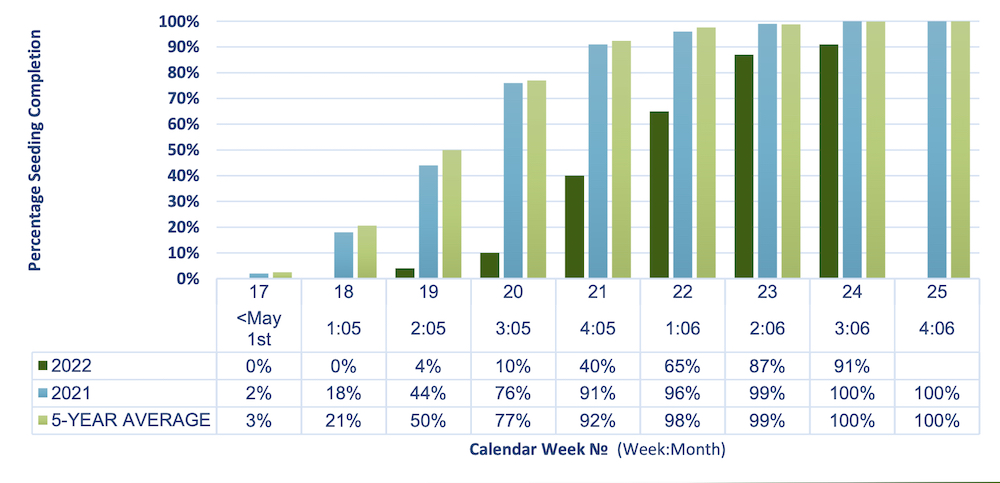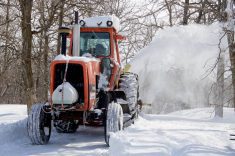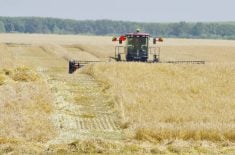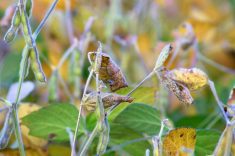Overview
A final push to finish seeding this past week brought a small increase in planted acres. Significant amounts of reseeded canola occurred from severe flea beetle damage, and crusting and flooding to a lesser extent.
Extreme heat brought on severe thunderstorms in large parts of the Southwest, Northwest, and Interlake regions over the weekend and yesterday. Heavy rains caused overland flooding, damaging crops and local road networks. Hail fell in a swath from Roblin to the Swan Valley of varying sized, damaging crops there, while other areas are having to contend with standing water pooling on fields and drowning crops that had established earlier. The southern part of the Central region, and Eastern region have seen rapid crop growth and fewer damaging weather events this past week.
Read Also
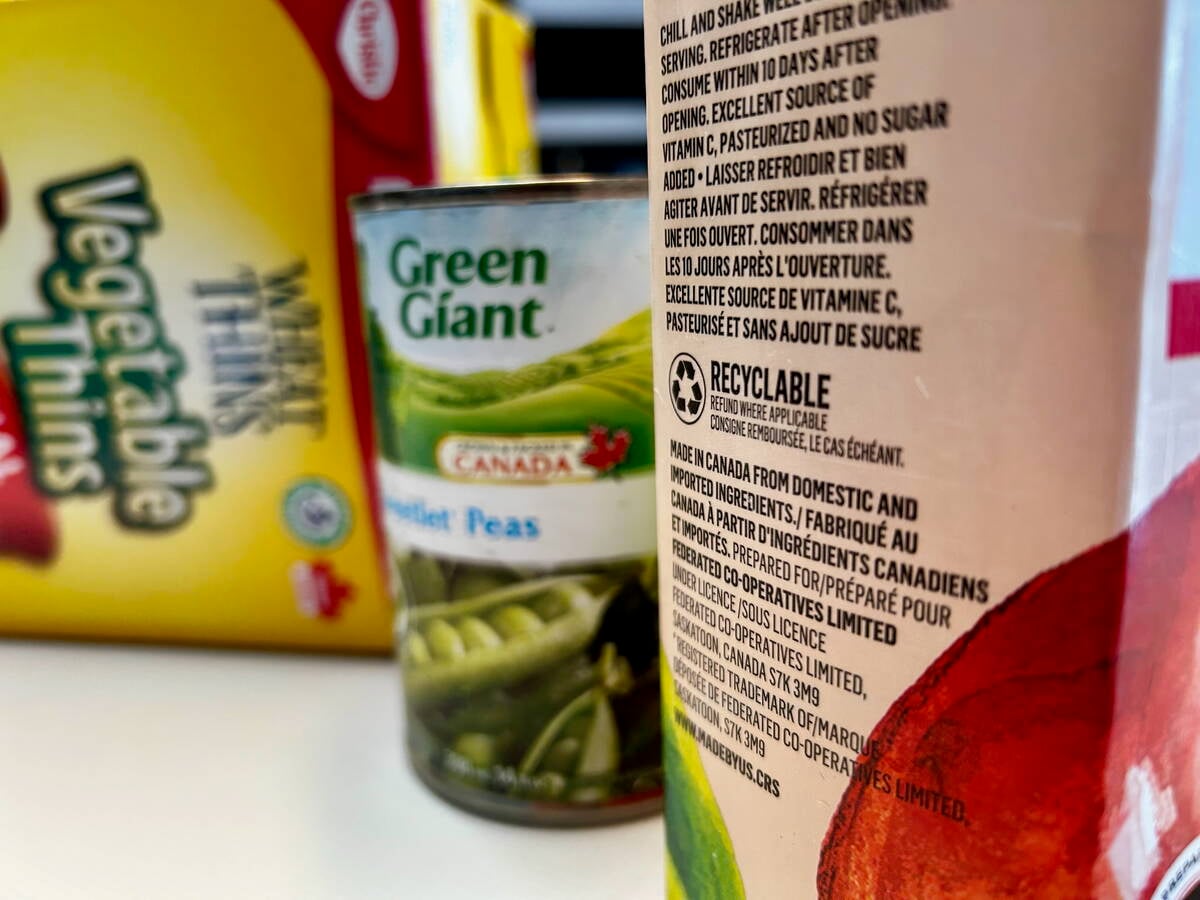
Unclear food labels hinder Canada’s ‘buy local’ surge
“Maple-washing” on Canadian food packaging makes label claims hard to keep straight and hurts both farmers and consumers trying to buy Canadian, economist says.
Saturated soils have stopped seeding progress once again, and those farmers yet to finish planting are coming to the realization that there will be unseeded acres on their farms this year. There were over 880,000 acres left unplanted as of June 20 seeding deadline, concentrated in the northwestern Interlake, along Lake Manitoba, in the Austin-Gladstone-Portage la Prairie area, and adjacent to the Red River.
Repeated rains and warm soils have led to widespread nitrogen fertilizer losses, either via leaching or denitrification. In-crop nitrogen-deficiency symptoms are showing up as chlorotic (yellowed) leaf margins, in combination with other symptoms of crop stress due to saturated soils. A drop in nitrogen prices (down approx. 30 per cent from spring highs) may encourage in-crop top-dressing. The rush to seed crops wherever possible led to poorer seedbeds in some cases, which will impact in-season management and harvested yields.
Ag retailers are dealing with supply issues of glufosinate (Liberty) herbicide, and short-season crop seed. Short- season seed is either destined to be a reseed or uninsurable late-seeded grain (barley) or forage (millet, sorghum) crop. Canola seed supply remains tight, depending on location, but has been sufficient to supply reseed needs in most cases.
Potato crops are mostly hilled, fields have adequate moisture and are being sprayed for weeds. A few fields have seen overhead irrigation commence as a cooling method, in response to extreme heat.
Livestock have been turned out to pasture, and forage growth is generally sufficient. Biting insects and mosquitoes are becoming a nuisance for cattle.
Cereals
Spring cereal seeding is nearly complete in all regions, and earliest seeded crops are now at the 4 to 5-leaf stage, and tillering well. Later seeded cereals have emerged, emergence varies by local area and soil conditions.
Rapid growth in cereals under warm and moist conditions are showing signs of temporary nitrogen deficiency in some fields, but recovering as roots expand. Some producers are top-dressing urea or UAN.
Fall rye is headed out, with most crops finished flowering and some fusarium head blight fungicide
applications made, while winter wheat crops are at flag leaf and just starting to head this week.
Barley crops are at 1- to 3-leaf stage, oats is generally 2- to 5-leaf and beginning to tiller on the oldest crops.
Grain corn development ranges from V2 to V3, and crops have finished the first herbicide pass.
Herbicide application has become the priority in cereals, with many crops being sprayed last week for lamb’s quarters, kochia, roundleaf mallow, amaranth-species (pigweeds), green and yellow foxtail, and volunteer canola and volunteer sunflowers.
Grasshopper nymph feeding damage has been reported in many crops in the Southwest, Central, and Interlake regions. Farmers and agronomists are encouraged to monitor grasshopper levels, stage and feeding in crops and vegetation around fields. Unless there is already heavy feeding to crops, a good time to start applying grasshopper control, should populations be high, is when the wing buds are becoming noticeable in the majority of grasshoppers.
Oilseeds
Emerged canola staging ranges from cotyledon to 6-leaf, with some fields starting to cabbage over, while others are stress-bolting due to excessive moisture earlier than anticipated.
Foliar application for flea beetles is widespread in canola fields in all regions, using permethrin as the active ingredient of choice, and moving to deltamethrin or lambda-cyhalothrin on subsequent applications. Flea beetle pressure has been heavy, yet inconsistent, with some fields requiring up to four foliar insecticide applications while nearby fields at similar stages have seen only minor damage. Later-seeded canola is consistently growing better, and seeing less damage and more rapid growth than earlier, more affected crops.
Farmers reported improved performance from diamide insecticidal seed treatments over standard package treatments in canola.
Flooded and crusted over fields last week have either recovered with light rains or have been reseeded, with an estimated 15 per cent of canola acres in the Central region being replanted, higher near Austin and Pilot Mound through Cartwright due to flea beetles and crusting, respectively. Some replanted fields are expected to be sown to barley once soil conditions permit due to short season constraints.
Flax is now 6 to 8 inches (15 to 20 cm) tall, herbicide application starting.
Sunflowers have emerged fairly well, stands appear to be average to above-average in density and survivability. Plants are now at V1 to V4.
Cutworm feeding was observed in some sunflowers, but plants are rapidly growing too large to see more injury from this pest, approximately half of fields were sprayed.
Pulses
Soybean acres in 2022 are reduced from previous years, with a projected 600,000 to 700,000 planted acres across Manitoba, down from the 1 million intended acres.
Soybeans are now established, and range from cotyledon (VE) to first trifoliate (V1).
Crusting was not an issue for peas or soybeans, and furrow-flipping was visible from the road.
The first in-crop herbicide application on soybeans is underway as winds permit, some field rolling also taking place on fields that were too wet to roll earlier after seeding.
Field pea crops range from V2 to V9 stage. Pea acres are expected to be between 140-160,000 acres, down from the planned 200,000 for 2022 as a result of changing cropping plans due to wet fields.
Field pea stands are looking good across most of Manitoba, despite strong thunderstorms, driving winds and hail damaging crops in the Swan River Valley, but peas are expected to recover with minimal yield impact, unless sitting in areas with pooled standing water.
Pea and dry bean fields that have been recently flooded from heavy rains will see substantial yield loss.
Fungicide application has started for field peas at V5 to V6 in the Southwest and Northwest regions, and most crops are now past the staging window for early in-crop herbicide application.
Dry edible bean crops acreage projections are at an estimated 100,000 to 110,000 acres planted, down approximately 20 per cent of the initial intended acreage in Manitoba at 120,000 to 130,000 acres.
A few dry bean crops are struggling with crusted soils, while most fields are at the unifoliate stage.
Forages & Livestock
Forages
Alfalfa stands are doing well, and filling in. Most crops are thick now over 12 inches in height. Low numbers of lygus bugs reported, and minimal damage in alfalfa crops for both forage and seed.
Brome grasses are now heading out, and hay yields are anticipated to be above average in the Northwest region.
Pasture condition is rated good to excellent in the Northwest region, with exceptions around Dauphin suffering from excess moisture.
Hayfields and pastures would benefit from heat and drier weather, needed for the upcoming haying season.
Most pastures seem to be keeping up with cattle feed demand. With receding floodwaters, pastures in floodplains and lower areas are also becoming available for use and starting to recover, while wet pastures will be damaged as cattle graze.
Livestock
Cattle have been turned out, and doing less damage to pastures than expected.
Reports of foot rot treatments and high black fly populations in some pastures.
Dairy farmers are in middle to end of their first cut in the Eastern region, and beef cattle producers have started first cut on fields that are dry enough to support machinery.
All creeks, streams, dugouts, and sloughs are full to overflowing.
Regional Comments
Southwest
Severe weather systems brought strong winds and heavy rains to the region, generally towards the northwest corner, washing out roads in the RMs of Oakview and Souris-Glenwood, with approximately 215 mm in the past 24 hours. Thunderstorms brought upwards of 100 mm rain in the RM of Prairie View near Binscarth, Foxwarren, and Angusville. Other districts received less rain further south.
Crops are suffering from excessive moisture, with standing water in many fields. Seeding progress for the region is 90 per cent complete, with a rapid push early last week to plant remaining acres that were not still waterlogged. Crop establishment has generally been good, and recently seeded crops have emerged and grown rapidly. Excessive rains are now stressing the crop and preventing pesticide application for weeds and flea beetles. Most prevalent weeds include biennial wormwood, green and yellow foxtail, wild oats, kochia, red root pigweed, and lamb’s quarters.
Northwest
Extreme heat over the weekend brought severe thunderstorms, leading to heavy rains up to 100 mm within 15 minutes near Benito, causing flash flooding of fields, ditches and over roads. Some washouts occurred and while crops did stand up to the flooding, it appears topsoil was removed. Extreme winds knocked over trees and bins, and hail ranging in size from the size of a dime to nearly golf-ball diameter shredded several crops and pastures in a swath 9 miles wide to approximately 30 miles long.
The Pas, Swan Valley and Roblin are mostly complete at approximately 99 per cent seeded; Dauphin/Grandview are approximately 85 per cent complete; while Ste. Rose is approximately 95 per cent complete. Ethelbert/Pine River and Laurier/McCreary are much delayed due to previous heavy rain and frequent rains continuing, and sit 40-50 per cent complete. Regional seeding completion is 89 per cen per cent done. Soil moisture is adequate to surplus in cropped and pasture fields in the region, recent rains have led to water pooling in low areas once again.
Central
Warm, relatively drier weather compared to other regions boosted Central Region seeding completion close to 94% done. Heavy rains again washed out and flooded the flat land along Pine Creek, and that area remains the furthest being in the region, at approximately 70 per cent seeded, prior to any new reseed issues. Much of the rest of the region has relatively even crops that are now filling in low spots or wheel tracks, with the notable exception of severely damaged canola fields, where the crop has been struggling to grow past intense flea beetle feeding despite numerous control efforts.
A significant number of fields will remain unseeded in the Austin-Gladstone-Portage la Prairie districts, where successive rains have saturated fields and rendered seeding impossible, with the exception of a few more broadcast canola acres.
Signs of nutrient deficiencies are becoming more noticeable in fields with lower organic matter, coarse-textured (sandy) soils where excessive moisture has leached soil-mobile nutrients deeper into the soil profile, away from small plant roots.
Eastern
Rainfall accumulations last week across the region ranged from 5 to 35 mm, with average rainfall amounts around 20 mm for the region. The majority of the rain fell on Tuesday, June 14th. Crop and weed growth were greatly accelerated because of the past week’s weather conditions. Part of this rapid growth was due to warm seasonal air temperatures that climbed up to way above seasonal towards the weekend. Seeding is virtually complete, at 97 per cent done, with reseed acres finished, and acres left unseeded will likely remain that way.
In northern parts of the region, dairy and beef cattle farms began haying, with initial quality reported as good. Too few acres have been cut to estimate yields. Progress is expected to ramp up quickly if weather is suitable.
Interlake
Rains have put a final stop to seeding efforts in parts of the Interlake region, notably along both sides of Lake Manitoba, and into the Fisher Branch/Fisherton area towards Arborg. Limited progress was made last week on seeding in the region, given the continually wet soils. Spotty emergence is the norm in the region. Some farmers raced last week to seed canola prior to crop insurance seeding deadlines, which have passed for all annual crops as of yesterday, June 20.
Some growers are sourcing alternative crop or forage seed with their retailers, looking at late (uninsurable) barley for grain or greenfeed, and planting millet or sorghum as a cattle feed and to soak up moisture and cover ground.

